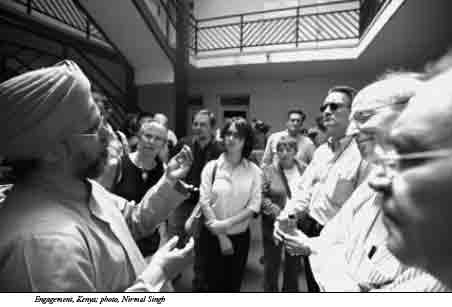Wayne Teasdale writes: Spirituality, in its interspiritual manifestation, is a vision of the spiritual life nourished by other schools of spirituality, mysticism, and contemplation, integrated with a person’s own tradition, if indeed the person is fortunate enough to have one. Interspirituality in this sense represents a spaciousness of being in the conduct of spiritual life, in the human search called the spiritual journey, that culminates in an understanding of spirituality that is sustained from its universal stream of mystical consciousness. In my studies, contemplative experience, travels, and time spent in India, I have encountered in depth mature members of all the world’s religions. I began to notice the common elements operative in their spiritual lives, and identified these elements in my book The Mystic Heart. All of these mature figures were spiritual teachers and saints in their particular tradition. I realized that if the fruits of the spiritual life, the contemplative, mystical process are the same, then the Source who inspired these transformed beings is the same. The one Divine Presence is behind it all, in every age. This insight has significance for peace-making in Asia, the Pacific, really indeed everywhere, and it is very meaningful as a major resource for transformation as we embrace the monumental task of reshaping our global political and economic culture.
The elements of a universal spirituality, or mysticism include:
1 actualized moral capacity
2 solidarity with the earth and all beings
3 deep nonviolence
4 humility of heart
5 spiritual practice
6 mature self-knowledge
7 simplicity of life and lifestyle
8 love in action – self-less service and compassionate action
9 prophetic voice and action.
All these aspects work together, and are essential to a fully formed and operative spiritual life in any part of the world.
The first element is that no genuine spirituality worth its salt lacks the moral dimension of a fully operative, or actualized practice. We see this principle at work in the lives of the saints of all traditions. Indeed, when the moral life has been inwardly actualized, the person no longer needs the external guides or norms to be moral, because the person is moral almost by nature. Mother Teresa, the Dalai Lama, Mahatma Gandhi, John Paul II, or any other holy person does not require any precepts or commandments to be good, since they are good by nature, disposition, and choice. It should be emphasized, however, that a genuine spiritual life is not possible without a functioning moral commitment.
The second element is that an awakened contemplative, mystic, saint, or anyone aspiring to be so, understands the intrinsic interdependence of all beings, all sentient beings, and certainly all human persons. Such a one grasps inwardly, existentially, this ontological truth of the interconnectivity of all life. It leads one to a deep sense of solidarity with all beings, and especially with the religions attests to the essential, ontological interdependence of all being. Hinduism speaks of non-duality, Buddhism of dependent arising, Christianity of the Mystical Body of Christ, all of which indicate the unitive character of reality. It is out of this ontological condition that the sense of solidarity emerges in the mystic’s vision of how he or she is related to everyone else.
The third element of a universal mysticism or spirituality is a commitment to deep nonviolence. This commitment occurs quite organically from the realization of our ontological, or essential interdependence, the intrinsic relatedness of all being. As one grows in holiness, integrity, and wisdom, understanding the nature of reality, one desires never to harm anyone else, even other sentient species. Saints and mystics, seers, and contemplatives become inherently nonviolent because they see so deeply into the nature of reality.It was Jainism that first awoke to the wisdom and necessity of non-harming. This principle is an absolute in the Jain tradition. Everything else in this faith is earth itself, which is the material basis of our aesthetic, and even our spiritual life here in this world. This interdependence is the ontological condition of humankind. Furthermore, social, economic, and political interdependence exists because of the deeper interconnection of all beings. Each of the great world —religions attests to the essential, ontological interdependence of all being. Hinduism speaks of non-duality, Buddhism of dependent arising, Christianity of the Mystical Body of Christ, all of which indicate the unitive character of reality. It is out of this ontological condition that the sense of solidarity emerges in the mystic’s vision of how he or she is related to everyone else.
It was Jainism that first awoke to the wisdom and necessity of non-harming. This principle is an absolute in the Jain tradition. Everything else in this faith is subordinate to it, even the truth itself. Both Buddhism and Hinduism were greatly influenced by Jainism in their adoption of the ideal of nonviolence, which was also an absolute commitment for Mahatma Gandhi, Martin Luther King, and now of the Dalai Lama, and his people, in their moral struggle with the People’s Republic of China. If we are ever to achieve a global society with a heart, then nonviolence is a vital value that we must learn and inculcate into the fabric of universal culture. I have felt for several years that what was manifested in Gandhi’s life is a gift from the Divine, a revelation of a critical skill we must implement if we are to engender the transformation of the world into a social order with a heart.
The fourth element of a universal spirituality is humility of heart. It is very clear from all the schools of mysticism that no progress in the spiritual journey is possible without this incisive virtue of humility. All the saints are imbued with its radiance, as are real mystics and contemplatives. Humility of heart is a clarity of truth about ourselves, and it is a deeply committed other-centeredness, a powerful desire not to manipulate others or reality. It is a respect for the freedom and dignity of all beings, and a reticence even to mention our own needs. It provides the necessary perspective in the spiritual life to negotiate obstacles, pitfalls, and the threat of self-deception. Humility keeps us honest, and on the path.
Spiritual practice is the fifth element in a universal spirituality, and is the crux of the matter in terms of those powerful breakthroughs that occur from time to time, and that are the substance of our relationship with the Divine or of our realization of infinite consciousness. Spiritual practice can include: prayer, meditation, chanting, liturgy and other rituals, singing, yoga, t’ai chi, spiritual reading, walking, and communion with the natural world. No spiritual life is either authentic or effective in the long run where a viable spiritual practice is absent. It is the cutting edge of inner realization, of the momentous eruptions of vision and insight in the spiritual journey. One’s spiritual life enters maturity when there is a commitment to a viable practice that is daily observed.
The sixth element concerns self-knowledge, which is profound, comprehensive, accurate, and indispensable to growth, transformation, and unitive experience. It works in tandem with humility and spiritual practice. It is nourished by regular exercises of -examination of conscience, of delving into our motives that are evident to us, or hidden from our sight in the depths of the unconscious. The lucidity and veracity of self-knowledge, its humble admission of our faults, and its uncertainty about our virtue, keeps us steadily on the path of self-transcendence, love, and a pervasive peace.
Simplicity of life, and of life-style, is the seventh element of global mysticism. The person who is living the spiritual life in its depth and plenitude always has this attachment to simplicity, to the unadorned state of focus on the essential reality, free of all that is extraneous. For example, in India, in the experience of Gandhi, his followers, and later in the life and example of Mother Teresa of Calcutta and her sisterhood of the Missionaries of Charity, simplicity of life was a cardinal ideal, what the Catholic tradition calls the vow of poverty. It means to live simply, or as Gandhi was fond of saying: “The earth has enough for humankind’s needs, but not its greeds.” There is a saying in the counter-culture of America that goes like this: “Live simply, so others may simply live!”
The eighth element of universal spirituality is love-in-action, self-less service, and compassionate response to the sufferings of others. This is the proof of the genuineness of one’s spiritual life. It cannot be real without this dimension of action out of love, kindness, compassion, and sensitivity. The capacity to respond to others from the innateness of love, compassion, kindness, and sensitivity is directly related to living his or her spiritual life. The more we are immersed in the Divine Presence, or exposed to infinite Awareness, the more we become love-in-action. It is the inner, natural, emergent intention of the person with a good heart, a perfected being, a holiness of life.
The ninth element of global mysticism is prophetic witness (or voice) and action. Authentic spirituality, when it is engaged with the world and the sufferings of the human community and other sentient species, is responsive to the sufferings of others, the struggles of the poor, vulnerable, homeless, the unwanted and unloved of humanity. The person of mystical spirituality in our time is prophetically engaged with the world. Such a person is always ready to take risks for the sake of peace, the environment, justice, equality, love, kindness, compassion, and sensitive awareness of the needs of others. The enlightened being will stick his or her neck out for others. Again, it’s an indication of the reality and maturity of one’s spirituality.
All of these elements are part of all twofold awareness: a vertical and horizontal dimension. Spirituality in its mystical fullness, extent, and depth, has a vertical direction that is an openness to and a direct awareness of the Divine Reality, the Spirit, God, Infinite Consciousness. It is a consciousness of the transcendent reality, the Source that grounds one’s spiritual commitment, and the mystical knowledge that arises from it. The second dimension of this awareness is equally indispensable, and is the horizontal direction of spiritual perception. It is the focus of loving awareness and action in relation to all others. It is animated by a depth of kindness and compassion, and the vast awareness of sensitivity that knows the preciousness of everyone and every-thing. Both these directions of awareness are the fruit of the spiritual life, and the fruitful foundation from which we can make peace in Asia, the Pacific, and the rest of the world.
[Source: http://www.interreligiousinsight.org/April2006/TeasdaleEssay.pdf]

